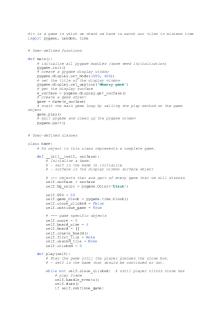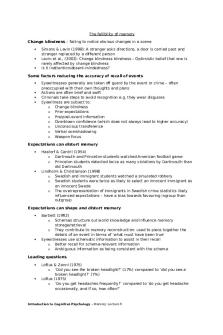STM vs LTM - Memory PDF

| Title | STM vs LTM - Memory |
|---|---|
| Author | Kemi Omoshebi |
| Course | Introduction to Cognitive Psychology |
| Institution | University of Bristol |
| Pages | 2 |
| File Size | 59.3 KB |
| File Type | |
| Total Downloads | 64 |
| Total Views | 131 |
Summary
Memory...
Description
Short-term vs long-term memory
Different types of memory Intuitively, it feels that long-lasting memories (“what’s the capital of Greece?”) are fundamentally different from memories storied for very brief durations (“Here is my phone number: 0793…”) Short-term memory (STM) o Holds information only very briefly, and has severely limited capacity o Articulatory rehearsal enables you to remember information by saying it back to yourself so as to keep the memory active Long-term memory (LTM) o Holds information over long period, and has potentially unlimited capacity What is STM good for? o Any complex cognitive tasks appears to require short-term storage (or “buffering”) of information. Examples: Arithmetic: 3 + 4 – (9 – 5) + 12 = ? Language: “Donald Trump thought that he won the election”- how do we know what “he” referred to? Presumably, “Donald Trump” Is temporarily “buffered” in STM… Vision- navigation in space Miller (1956)- the magic number seven (+-2) o “My problem is that I have been persecuted by an integer. For seven years this number has followed me around, has intruded in my most private data, and has assaulted me from the pages of our most public journals. This number assumes a variety of disguises, being sometimes a little larger and sometimes a little smaller than usual, but never changing so much as to be recognisable. The persistence with which this number plagues me is far more than a random accident. […] Either there really is something unusual about the number or else I am suffering from delusions of persecution.” Capacity of STM o Individuals can hold around 7 items simultaneously STM (Miller, 1956) o Capacity largely independent of nature of items: Digits: 9247381 Letters: TMFJRLB Words: HAT CUP BOOT LOG TEA ROOM WINE o But capacity is less than seven for items that don’t mean anything “Nonwords”: PLOCK TWEB DRUNG VUKE DRAND BLAY o If possible, short term memory makes contact with representations which are permanently stored in our minds “Digit span task” o Common component of many IQ tests, including the widely used Wechsler Adult Intelligence Scale (WAIS) o Screening test for clinical impairments (eg. dementia) o Read out three digits (3, 1, 4) in a monotonous voice, with one digit read per second o If correctly recalled, increased to four digits (7, 3, 5, 1) o If correctly recalled, increased to five etc. (in a clinical setting, task is often stopped after five digits) “Superspan lists”- less-than-perfect performance o Present lists of items longer than max. capacity of STM (around 7) o Free recall task: recall the list of items, in any order o Across many trials, plot average recall probability (y-axis) dependent on list position (x-axis). Eg. for list of 12 letters: U-shaped function (items at beginning and end well-recalled; items in middle less well-recalled) o “Serial position curve” o Primacy effect- reflects contribution of LTM (earlier items undergo more rehearsal) o Recency effect- reflects contribution of STM (items that are still active in short-term store are recalled better) Post-list distractor items
Glanzer and Cunitz (1966)- if recently effect is due to STM, it should be eliminated if participants perform irrelevant distractor task after list (but before recall) o Participants count for either 10 or 30 seconds after list presentation (or they recall immediately, in the 0 second condition) o Recency effect visible in the 0 second- baseline- condition is virtually eliminated by post-list distractor items Acquired brain damage o Cases of normal STM but impaired LTM? Yes o Eg. Milner (1966): the case of HM o Suffered from intractable epilepsy o Part of his temporal lobes surgically removed, including hippocampus o Showed defectrive LTM learning- inability to acquire new information post surgery (“anterograde amnesia”) o But had normal STM Double dissociation between STM and LTM o Cases of normal LTM but impaired STM? Yes! o Shallice & Warrington (!970): the case of KF- brain damage following motorbike accident o LTM performance in normal range (learning of word pairs, lists of words, etc.) o STM dramatically impaired: usual digit span of 7+-2 reduced to max. 2 o Neuropsychological evidence suggests that STM and LTM are separate memory systems Modal model of memory (eg. Atkinson & Shiffrin, 1968) o Memory consists of a flow of information that passes through three stages: sensory memory, a short-term memory and a long-term memory o For something to enter LTM, it has to pass through STM o STM has limited capacity of about seven or so items o The longer an item held in STM, the more likely to be transferred to LTM o Info can be “refreshed” in STM by means of rehearsal Sensory memory o First stage of memory formation o As we have more than one sense, we too have more than one kind of sensory memory o Iconic memory: fast-decaying store of visual information o Echoic memory: fast-decaying store of auditory information Summary and key points o Distinction between STM and LTM is fairly intuitive o STM capacity is severely limited o Double dissociation between STM and LTM regarding acquired brain damage o “Modal model of memory”- progress separate memory systems for STM and LTM, and logical sequence of how something can enter LTM (ie. via STM) o The transferring of memories is called consolidation- the process whereby information must pass from short-term memory into long-term memory in order for it to be remembered (Craick and Lockhart, 1972) o
...
Similar Free PDFs

STM vs LTM - Memory
- 2 Pages

Memory
- 3 Pages

Memory
- 5 Pages

Tarifs variables STM - Article
- 2 Pages

STM TAJUK 1A PENCIPTAAN MANUSIA.ppt
- 34 Pages

STM 304 June, 2020 Assignment
- 4 Pages

MAKALAH STM 3 Literasi Sains
- 13 Pages

Virtual Memory
- 58 Pages

CACHE MEMORY
- 1 Pages

01-LTM-CL 1-Nadiya Nurul Huda
- 1 Pages

Memory Psych
- 1 Pages

Virtual Memory
- 17 Pages
Popular Institutions
- Tinajero National High School - Annex
- Politeknik Caltex Riau
- Yokohama City University
- SGT University
- University of Al-Qadisiyah
- Divine Word College of Vigan
- Techniek College Rotterdam
- Universidade de Santiago
- Universiti Teknologi MARA Cawangan Johor Kampus Pasir Gudang
- Poltekkes Kemenkes Yogyakarta
- Baguio City National High School
- Colegio san marcos
- preparatoria uno
- Centro de Bachillerato Tecnológico Industrial y de Servicios No. 107
- Dalian Maritime University
- Quang Trung Secondary School
- Colegio Tecnológico en Informática
- Corporación Regional de Educación Superior
- Grupo CEDVA
- Dar Al Uloom University
- Centro de Estudios Preuniversitarios de la Universidad Nacional de Ingeniería
- 上智大学
- Aakash International School, Nuna Majara
- San Felipe Neri Catholic School
- Kang Chiao International School - New Taipei City
- Misamis Occidental National High School
- Institución Educativa Escuela Normal Juan Ladrilleros
- Kolehiyo ng Pantukan
- Batanes State College
- Instituto Continental
- Sekolah Menengah Kejuruan Kesehatan Kaltara (Tarakan)
- Colegio de La Inmaculada Concepcion - Cebu



